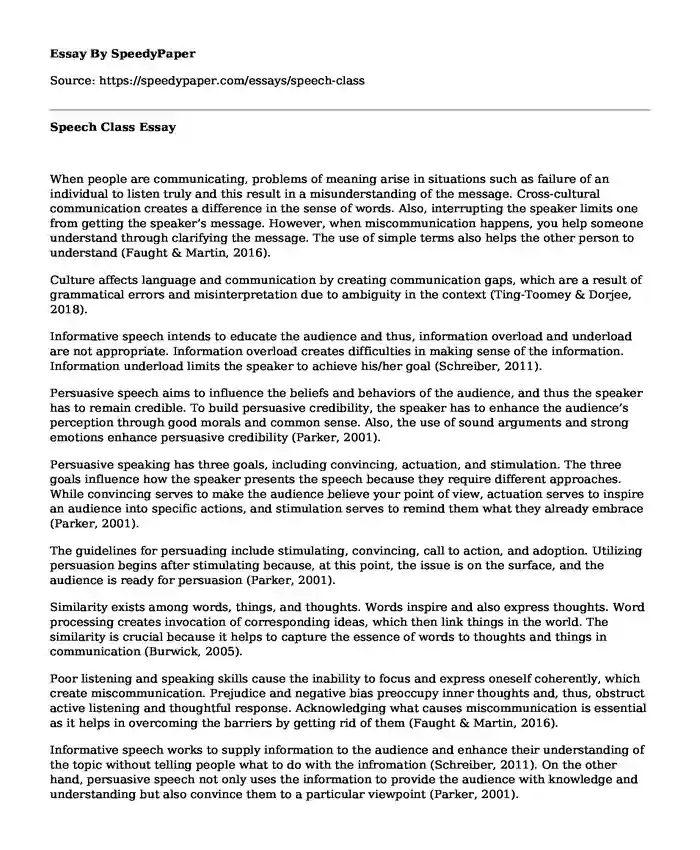
| Type of paper: | Essay |
| Categories: | Philosophy Government Ethics Accounting Essays by pagecount |
| Pages: | 2 |
| Wordcount: | 549 words |
When people are communicating, problems of meaning arise in situations such as failure of an individual to listen truly and this result in a misunderstanding of the message. Cross-cultural communication creates a difference in the sense of words. Also, interrupting the speaker limits one from getting the speaker's message. However, when miscommunication happens, you help someone understand through clarifying the message. The use of simple terms also helps the other person to understand (Faught & Martin, 2016).
Culture affects language and communication by creating communication gaps, which are a result of grammatical errors and misinterpretation due to ambiguity in the context (Ting-Toomey & Dorjee, 2018).
Informative speech intends to educate the audience and thus, information overload and underload are not appropriate. Information overload creates difficulties in making sense of the information. Information underload limits the speaker to achieve his/her goal (Schreiber, 2011).
Persuasive speech aims to influence the beliefs and behaviors of the audience, and thus the speaker has to remain credible. To build persuasive credibility, the speaker has to enhance the audience's perception through good morals and common sense. Also, the use of sound arguments and strong emotions enhance persuasive credibility (Parker, 2001).
Persuasive speaking has three goals, including convincing, actuation, and stimulation. The three goals influence how the speaker presents the speech because they require different approaches. While convincing serves to make the audience believe your point of view, actuation serves to inspire an audience into specific actions, and stimulation serves to remind them what they already embrace (Parker, 2001).
The guidelines for persuading include stimulating, convincing, call to action, and adoption. Utilizing persuasion begins after stimulating because, at this point, the issue is on the surface, and the audience is ready for persuasion (Parker, 2001).
Similarity exists among words, things, and thoughts. Words inspire and also express thoughts. Word processing creates invocation of corresponding ideas, which then link things in the world. The similarity is crucial because it helps to capture the essence of words to thoughts and things in communication (Burwick, 2005).
Poor listening and speaking skills cause the inability to focus and express oneself coherently, which create miscommunication. Prejudice and negative bias preoccupy inner thoughts and, thus, obstruct active listening and thoughtful response. Acknowledging what causes miscommunication is essential as it helps in overcoming the barriers by getting rid of them (Faught & Martin, 2016).
Informative speech works to supply information to the audience and enhance their understanding of the topic without telling people what to do with the infromation (Schreiber, 2011). On the other hand, persuasive speech not only uses the information to provide the audience with knowledge and understanding but also convince them to a particular viewpoint (Parker, 2001).
When giving an informative speech, there are two aspects to remember and keep utilizing when presenting. They include explaining the specific topic and ensuring that the audience will remember the knowledge later (Schreiber, 2011).
References
Burwick, F. (2005). Mendelssohn and Coleridge on Words, Thoughts, and Things. In The Jews and British Romanticism (pp. 245-273). Palgrave Macmillan, New York.
Faught, S., & Martin, T. (2016). When does communication turn into miscommunication? A case study. International Journal of the Academic Business World, 10(2), 27-31.
Parker, D. (2001). Delivering a persuasive speech. The Internet TESL Journal, 7(8).
Schreiber, L. (2011). informative speaking. The Public Speaking Project (Ed.). Public speaking. The virtual text, 15-1.
Ting-Toomey, S., & Dorjee, T. (2018). Communicating across cultures. Guilford Publications.
Cite this page
Speech Class. (2023, May 14). Retrieved from https://speedypaper.com/essays/speech-class
Request Removal
If you are the original author of this essay and no longer wish to have it published on the SpeedyPaper website, please click below to request its removal:
- Cold War - Free Writing Assignment Example
- Free Essay: Abortion Comparison Between Urban and Rural Cities
- Essay Example about Poverty in Children
- Essay Example: Market Conditions and Competitive Analysis of Apple Inc.
- Research Paper Sample: Normal Physiology of Cells and Effects of Cancer on Cells System
- Free Paper Sample on Gender Issues in Family Therapy
- Paper Example on Long-Term Control and Quick Relief Treatment for Asthma
Popular categories




